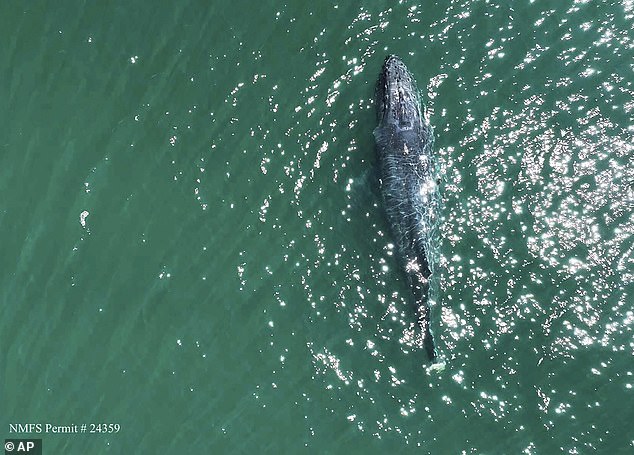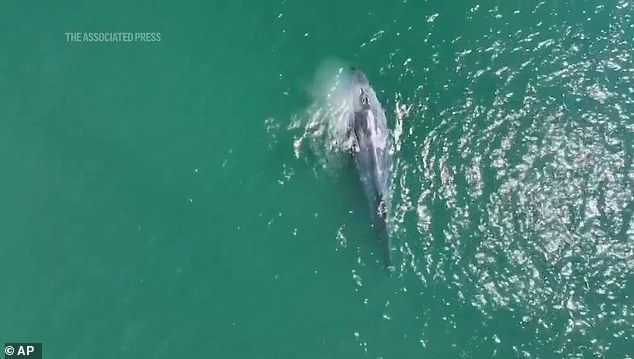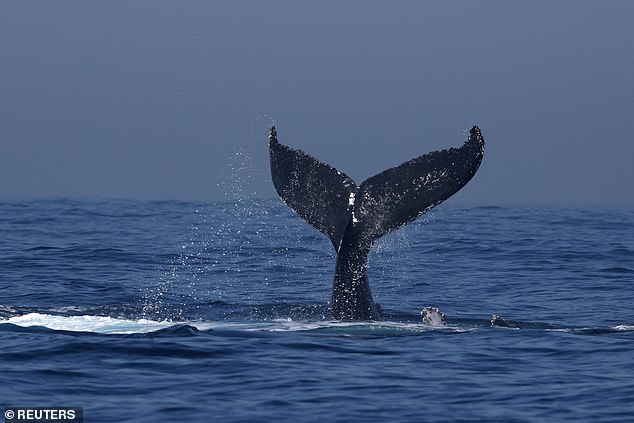Wildlife experts spot devastating problem with ocean giant – as they reveal likely cause
Marine animal researchers recently made a heartbreaking discovery when they spotted a humpback whale in the ocean near Washington state.
The mammal had a serious problem: its tail was missing.
The dramatic drone video from July 23 shows the whale swimming, and for a second, everything seems normal. That is, until the massive sea creature dives underwater, revealing its severed appendage.
Their distinctive tail fins are their primary means of propulsion through the water, and experts are very concerned about this.
John Calambokidis, a research biologist at Cascadia Research Collective, said the Associated Press that it is unlikely that a humpback whale would survive for long without its flukes.
When the whale dives, it becomes much more apparent that it is missing its flippers, which are crucial for propelling the mammal through the water
Jessica Farrer, director of research at the Whale Museum on San Juan Island in Washington, was part of a team of scientists who responded to the whale sighting in late July.
The whale was first spotted in the Salish Sea, the inland waters between Washington and British Columbia.
But there have been no other sightings since then, Farrer said.
“Everybody has an emotion when they see a humpback whale diving, and you see these huge fins that are over 15 feet wide, and here’s this whale, it’s just lost them. It’s like us losing our legs,” Farrer said.
Farrer and the many experts who have reviewed the photos of the whale agree that the animal lost its flippers because it became entangled in the water.
According to NOAA Fisheries, it is possible the humpback whale became entangled in mooring lines, pots or nets.
The agency also says entangled marine life can be struck by boats while they are stationary.

This aerial photo from The Whale Museum was taken at an island off the coast of Washington state on July 23, 2024. It shows a humpback whale missing its tail

The tailless humpback whale can be seen spouting through its blowhole, the process by which it exhales water vapor
“There are so many entanglement hazards floating around in the world’s oceans. Old fishing gear that has come loose from fishing boats or the gear that they leave behind,” Farrer said.
‘And these whales have to swim through that and humpbacks are at greater risk because they have those really long pectoral fins.’
Farrer’s main concern is that the tailless whale will not be able to swim fast enough to keep up with smaller fish and feed itself.
Statistics from NOAA Fisheries show there were 16 confirmed entanglements with humpback whales off the coasts of Washington, Oregon and California last year.
The year 2016 was particularly bad for entanglements with humpback whales, with more than 40 entanglements in total.
This was likely because it was Dungeness crab fishing season in California that year, which likely required the whales to navigate with much more fishing gear, AP reported.
California has since changed the way it regulates the commercial Dungeness crab fishery to prevent animals from becoming entangled in the fish.
Justin Viezbicke, an entangled whale responder with NOAA Fisheries, says that along the West Coast, whales without fins are sighted about once every year or two.

This is what a humpback whale’s tail usually looks like. The fins can be up to 15 feet wide from tip to toe
He added that this anecdotal estimate is likely a gross underestimation of the true number of whales that have lost their tails due to human intervention.
Calambokidis also said there are likely more tailless whales than ever reported.
Still, he said humpback whale populations on the West Coast are growing and thriving, despite the many threats.
Farrer hopes the shocking images of the seriously injured humpback will be a wake-up call and lead to even stronger conservation measures.
“It’s one thing to show pictures of whales that have become entangled, or to talk about whales that have died from entanglement, or to see entanglement scars, but this whale swimming in the Salish Sea without a tail is a textbook example of the dangers they face.”
